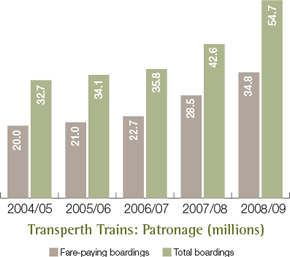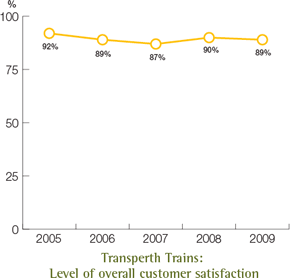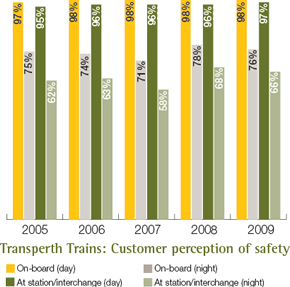Transperth Trains
Description of services
The TTO division operates an electrified suburban train system with more than 1040 services on an average weekday, and more than 6640 weekly services.
At 30 June 2009, the system covered 173.1km of track with 70 stations on five lines, and a fleet of 198 railcars which can be coupled in configurations of two, three, four or six-car trains.
The train network consists of the Joondalup Line (33.2km), the Fremantle Line (19km), the Midland Line (16km), the Armadale/Thornlie Line (30.5km, and a 3km spur line to Thornlie), and the Mandurah Line (71.4km).
The year’s developments
- The significant increase in train service kilometres following the extension of the rail network, continued in 2008/09. In 2007/08, train service kilometres increased by 44.4 per cent following the start of services on the Mandurah Line in December 2007. In 2008/09, the full-year impact of the new line was seen when train service kilometres increased a further 19.7 per cent to 14.531 million from 12.138 million in 2007/08.
- Similarly, total capacity provided on the train network continued to increase. Following the 53.4 per cent increase in passenger place kilometres (to 4600.8 million) in 2007/08 when the Mandurah Line started services, a further increase of 22.6 per cent to 5641.3 million was recorded.
- The installation of the RAPID system on all A-series trains was completed during the year. RAPID, which incorporates the latest in digital technology, increases the number of railcar security cameras, provides passenger information displays in railcars, bright LED destination indicators, and improved message announcements.
- The installation of the new touch-screen TVMs was completed in July 2008. All machines accept coins and some also accept banknotes and EFTPOS debit cards, providing passengers more payment options for cash fares.
- The PTA took delivery of the first nine railcars (three 3-car sets) of the 45 B-series railcars on order. The timetables for the Joondalup, Mandurah, Midland and Fremantle lines were amended from 28 June 2009 to accommodate the new railcars. Issues relating to a new internal communications system delayed the first railcar sets (six railcars) entering into service but the third 3-car set was delivered slightly ahead of schedule. The delay was due to the design and commissioning process of the new Integrated Communications System (ICS), which is being installed on these railcars, falling behind schedule. It is anticipated that this delay will only impact on the first two railcar sets and that the remaining railcars will be delivered on time. The ICS controls all communications on the railcars including the automated message announcements, passenger information displays, CCTV and passenger emergency intercoms.
- TTO continued to recruit and train staff for the provision of customer service and security services.
- Work on the underfloor railcar wheel lathe at Nowergup Depot and associated infrastructure works was completed during the year. The wheel lathe will allow PTA to re-machine railcar wheels and brake disks in the inter-peak period and provide fast turnaround of railcars.
Cost of the service
In 2008/09, the total cost of providing Transperth train services, including annual capital charges, was $363.732 million, an increase of 22.9 per cent over the 2007/08 total cost of $296.026 million. Capital charges increased by 46.9 per cent from $94.577 million to $138.914 million.
Train operating costs (i.e excluding capital charges) increased 11.6 per cent from $201.449 million in 2007/08, to $224.818 million (including $14.516 million in expenses for the transfer of assets related to rail systems development to local government). (For comparison purposes, the 2007/08 operating cost has been adjusted to include these expenses which amounted to $19.246 million.) Excluding the expenses associated with the transfer of rail-related assets to local government, the increase in TTO operating costs was 15.4 per cent, which reflects the full-year cost of operating the Mandurah Line.
Patronage
Patronage on Transperth train services continued to increase at a significant rate for the fifth year in succession. In 2008/09, fare-paying boardings increased by 22.3 per cent to 34.815 million while total boardings increased by 28.4 per cent to 54.750 million. The significant increases recorded in 2008/09 followed growth rates of 25.6 per cent and 19.2 per cent in fare-paying and total boardings respectively in 2007/08.
These rates of growth reflect the impact of Mandurah Line operations for six months of 2007/08. Comparing on a like-for-like basis, (i.e. Mandurah Line operations for the six-month period January to June), shows that fare-paying boardings on the train system increased 4.3 per cent from 16.444 million in 2008 to 17.156 million in 2009. Total boardings over the same period rose nine per cent from 25.119 million to 27.369 million.
Boardings per service kilometre on the train network also recorded an improvement in 2008/09. While service kilometres increased by 19.7 per cent to 14.531 million from 12.138 million in 2007/08, fare-paying and total boardings rose 22.3 per cent and 28.4 per cent respectively. Consequently, on a per service kilometre basis over the two years, fare-paying boardings were 2.396 in 2008/09 compared with 2.345 in 2007/08 while total boardings increased to 3.77 from 3.51.
An increasing number of train passengers are able to access the network though Park ’n’ Ride facilities at train stations. At 30 June 2009, there were a total of 15,957 parking bays across the system (Joondalup Line 5964 bays, Mandurah Line 5633 bays, Armadale Line 2346 bays, Midland Line 1469 bays and Fremantle Line 545 bays).
Passenger satisfaction
The 2009 Transperth PSM showed that the proportion of users who expressed overall satisfaction with the train system declined marginally to 89 per cent from 90 per cent in 2008.
The importance rating of the key service characteristics of Transperth’s train services (other than passenger safety) and the level of satisfaction/dissatisfaction for each key service characteristic are shown in the table below. In 2009, the satisfaction rating increased for "punctuality" and for "SmartRider ticketing system". While satisfaction with "speed of trip" remained unchanged at 93 per cent, there was a slight reduction in the satisfaction rating for the other key service characteristics.
|
SERVICE CHARACTERISTIC |
IMPORTANCE RATING |
SATISFACTION RATING |
||
|---|---|---|---|---|
|
2008 |
2009 |
2008 |
2009 |
|
|
Cost of fares |
71% |
68% |
67% (8%) |
66% (7%) |
|
Punctuality |
63% |
64% |
90% (5%) |
94% (2%) |
|
Cleanliness on board |
60% |
64% |
87% (6%) |
86% (5%) |
|
Speed of the trip |
64% |
60% |
93% (2%) |
93% (3%) |
|
Availability of seats |
55% |
59% |
80% (14%) |
77% (17%) |
|
Off-peak service frequency |
51% |
49% |
87% (5%) |
85% (5%) |
|
Peak service frequency |
50% |
49% |
82% (10%) |
81% (12%) |
|
Provision of electronic ticketing facilities/SmartRider electronic ticketing |
37% |
42% |
90% (5%) |
93% (4%) |
Note: Dissatisfaction level shown in parentheses.
Passenger safety
The 2009 PSM asked train users: "How safe do you generally feel from personal interference or threat from other passengers?"
The above graph shows the proportion of respondents who "always" or "usually feel safe" at the specified times at the specified locations.
The results for the past five years show that the proportion of train passengers who generally feel safe on trains and at station/interchanges during the day has remained high. However, the 2009 PSM revealed that the proportion of passengers who "always" or "usually feel safe" at night declined marginally. In 2009, 76 per cent of train users generally felt safe on trains at night compared with 78 per cent in 2008 and 71 per cent in 2007. The proportion of train users who generally felt safe at stations/interchanges at night was 66 per cent in 2009, a marginal reduction from the 2008 result of 68 per cent but significantly better than the 58 per cent recorded in 2007.
The PTA is committed to ensuring that all passengers feel safe on the train network at all times. To achieve this aim, the centralised monitoring of digitised CCTV footage from all train stations via a state-of-the-art monitoring centre is carried out 24 hours a day, seven days a week.
To assist transit officers in their security and customer safety role, the PTA has the ability to issue orders to ban repeat offenders guilty of violence, graffiti, vandalism or anti-social behaviour from using public transport services.
To achieve full transit officer staffing levels, an active recruiting program continued during the year.
Major initiatives for 2009/10
- Provide operational expertise into the forward planning for the extension to the Joondalup Line, and for the Northbridge Link project
- Continue recruitment of staff to service customer needs on the system
- Continue to take delivery of and commission into service the new B-series three-car trains
- Commence the installation of the platform detection system into A-series railcar


